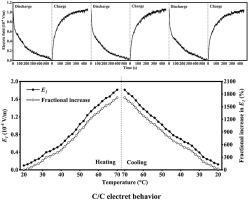Our official English website, www.x-mol.net, welcomes your feedback! (Note: you will need to create a separate account there.)
Electret behavior of carbon fiber structural composites with carbon and polymer matrices, and its application in self-sensing and self-powering
Carbon ( IF 10.9 ) Pub Date : 2020-04-01 , DOI: 10.1016/j.carbon.2020.01.035 Xiang Xi , D.D.L. Chung
Carbon ( IF 10.9 ) Pub Date : 2020-04-01 , DOI: 10.1016/j.carbon.2020.01.035 Xiang Xi , D.D.L. Chung

|
Abstract Continuous carbon fiber carbon-matrix (C/C) and polymer-matrix (CFRP) structural composites without poling are electrets. Their DC electric field E (hence the volumetric power density Pv for structural self-powering) increases linearly with increasing inter-electrode distance l (more significantly for C/C). Short-circuit discharge and open-circuit self-charge occur reversibly. The fraction of carriers that participate is 1.6 × 10−3 and 2.8 × 10−3 for CFRP and C/C, respectively. At l = 140 mm, E = 1.2 × 10−4 V/m, and Pv is 5.0 × 10−5 and 2.5 × 10−4 W/m3 for CFRP and C/C, respectively. The participating carrier density is 2.4 × 1021 and 2.6 × 1022 m−3, and the discharge time per unit participating charge is 6.7 × 106 and 8.9 × 104 s/C for CFRP and C/C, respectively. The C/C gives higher power density, whereas CFRP discharges more slowly. The polarization-induced apparent resistance increase upon DC current polarity reversal is asymmetrical. Elastic tension affects E, relative permittivity κ and resistivity ρ essentially reversibly and linearly (more significantly for C/C), enabling piezoelectret/piezoresistive self-sensing and piezoelectret-based energy harvesting. The strain causes CFRP to increase in E, κ and ρ, and C/C to decrease in E and ρ and increase in κ. Increasing the temperature from 20 °C to 70 °C increases E reversibly by 1900% and increases the volumetric power density by 40000%, as shown for C/C.
中文翻译:

碳基和聚合物基碳纤维结构复合材料的驻极体行为及其在自传感和自供电中的应用
摘要 无极化的连续碳纤维碳基(C/C)和聚合物基(CFRP)结构复合材料是驻极体。它们的直流电场 E(因此结构自供电的体积功率密度 Pv)随着电极间距离 l 的增加而线性增加(对于 C/C 更显着)。短路放电和开路自充电可逆发生。对于 CFRP 和 C/C,参与的载波比例分别为 1.6 × 10-3 和 2.8 × 10-3。在 l = 140 mm 时,E = 1.2 × 10−4 V/m,对于 CFRP 和 C/C,Pv 分别为 5.0 × 10−5 和 2.5 × 10−4 W/m3。CFRP 和 C/C 的参与载流子密度分别为 2.4 × 1021 和 2.6 × 1022 m-3,单位参与电荷的放电时间分别为 6.7 × 106 和 8.9 × 104 s/C。C/C 提供更高的功率密度,而 CFRP 放电更慢。直流电流极性反转时极化引起的表观电阻增加是不对称的。弹性张力基本上可逆和线性地影响 E、相对介电常数 κ 和电阻率 ρ(对于 C/C 更显着),从而实现压电驻极体/压阻式自感应和基于压电驻极体的能量收集。该应变导致 CFRP 的 E、κ 和 ρ 增加,而 C/C 导致 E 和 ρ 的减少和 κ 的增加。将温度从 20 °C 提高到 70 °C,E 可逆地增加 1900%,体积功率密度增加 40000%,如 C/C 所示。实现压电驻极体/压阻式自感应和基于压电驻极体的能量收集。该应变导致 CFRP 的 E、κ 和 ρ 增加,而 C/C 导致 E 和 ρ 的减少和 κ 的增加。将温度从 20 °C 提高到 70 °C,E 可逆地增加 1900%,体积功率密度增加 40000%,如 C/C 所示。实现压电驻极体/压阻式自感应和基于压电驻极体的能量收集。该应变导致 CFRP 的 E、κ 和 ρ 增加,而 C/C 导致 E 和 ρ 的减少和 κ 的增加。将温度从 20 °C 提高到 70 °C,E 可逆地增加 1900%,体积功率密度增加 40000%,如 C/C 所示。
更新日期:2020-04-01
中文翻译:

碳基和聚合物基碳纤维结构复合材料的驻极体行为及其在自传感和自供电中的应用
摘要 无极化的连续碳纤维碳基(C/C)和聚合物基(CFRP)结构复合材料是驻极体。它们的直流电场 E(因此结构自供电的体积功率密度 Pv)随着电极间距离 l 的增加而线性增加(对于 C/C 更显着)。短路放电和开路自充电可逆发生。对于 CFRP 和 C/C,参与的载波比例分别为 1.6 × 10-3 和 2.8 × 10-3。在 l = 140 mm 时,E = 1.2 × 10−4 V/m,对于 CFRP 和 C/C,Pv 分别为 5.0 × 10−5 和 2.5 × 10−4 W/m3。CFRP 和 C/C 的参与载流子密度分别为 2.4 × 1021 和 2.6 × 1022 m-3,单位参与电荷的放电时间分别为 6.7 × 106 和 8.9 × 104 s/C。C/C 提供更高的功率密度,而 CFRP 放电更慢。直流电流极性反转时极化引起的表观电阻增加是不对称的。弹性张力基本上可逆和线性地影响 E、相对介电常数 κ 和电阻率 ρ(对于 C/C 更显着),从而实现压电驻极体/压阻式自感应和基于压电驻极体的能量收集。该应变导致 CFRP 的 E、κ 和 ρ 增加,而 C/C 导致 E 和 ρ 的减少和 κ 的增加。将温度从 20 °C 提高到 70 °C,E 可逆地增加 1900%,体积功率密度增加 40000%,如 C/C 所示。实现压电驻极体/压阻式自感应和基于压电驻极体的能量收集。该应变导致 CFRP 的 E、κ 和 ρ 增加,而 C/C 导致 E 和 ρ 的减少和 κ 的增加。将温度从 20 °C 提高到 70 °C,E 可逆地增加 1900%,体积功率密度增加 40000%,如 C/C 所示。实现压电驻极体/压阻式自感应和基于压电驻极体的能量收集。该应变导致 CFRP 的 E、κ 和 ρ 增加,而 C/C 导致 E 和 ρ 的减少和 κ 的增加。将温度从 20 °C 提高到 70 °C,E 可逆地增加 1900%,体积功率密度增加 40000%,如 C/C 所示。


























 京公网安备 11010802027423号
京公网安备 11010802027423号